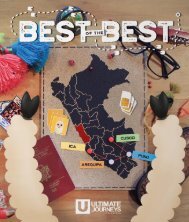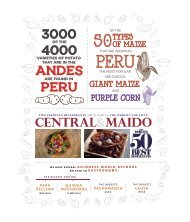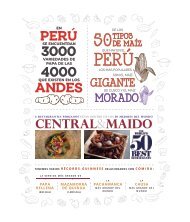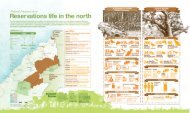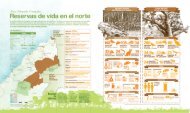UJ #17 - Traditional Peru
Create successful ePaper yourself
Turn your PDF publications into a flip-book with our unique Google optimized e-Paper software.
JANUARY | ANNIVERSARY OF LIMA<br />
Lima is the capital of <strong>Peru</strong>, and its biggest city, with<br />
more than 9 million inhabitants. As the central hub<br />
of the country, it contains government and business<br />
headquarters, and emulates modernity while consciously<br />
respecting its history.<br />
A little over 483 years ago, on January 18th 1535, a<br />
Spanish explorer by the name of Francisco Pizarro<br />
founded Lima, The City of Kings. Since then, the calm city<br />
originally established next to the Rimac River – the main<br />
river during the Viceroyalty – has transformed into one<br />
of the main metropolis in South America.<br />
Lima is more than just tall buildings and transited<br />
streets, however. Lima is the Pacific Ocean, the Historic<br />
Centre – a UNESCO World Heritage Site -; it is good food,<br />
bohemian culture, and so much more. Thus, each year,<br />
on the city’s anniversary, we celebrate this unparalleled<br />
combination of history and modernity, of ceviche and<br />
pisco sour.<br />
When honouring Lima, one must return to where it all<br />
began: the Historic Centre. Before the Spanish even set<br />
foot on our coast, Lima was part of different cultures and<br />
empires – from the Ischma to the Inca. What is now the<br />
main plaza, the Main Square, was originally the site of an<br />
ancient government centre with impressive ceremonial<br />
structures. The area also formed part of the famed Qhapaq<br />
Ñan: a network of roads and paths over 60,000 kilometres<br />
long that unified the entire Inca Empire.<br />
It was upon these huacas that the Spanish conquistadors<br />
decided to build their own constructions. The palace<br />
of chief Taulichusco became the Government Palace<br />
the temple of Puma-Inti became the main Cathedral,<br />
and what was the ‘town hall’ became the Municipality.<br />
Meanwhile, the central corrals, where animals were kept,<br />
were replaced with a bronze fountain. The beautiful<br />
Gothic churches, bull-fighting plazas, and numerous<br />
other constructions became testaments to the<br />
importance of this thriving city.<br />
IN 1991 LIMA’S HISTORIC CENTRE WAS<br />
DECLARED A WORLD HERITAGE SITE BY<br />
UNESCO THANKS TO THE DEDICATION<br />
OF THE PATRONATO DE LIMA, CREATED<br />
BY EDUARDO R. ARRARTE, FOUNDER OF<br />
LIMATOURS.<br />
Following the independence, the economic crisis, and<br />
the War of the Pacific, however, Lima was left devastated<br />
and desolated. Soon there after, the city experienced a<br />
renaissance; the walls that surrounded the city to protect<br />
Rafael Cornejo / PromPerú<br />
LimaTours<br />
12<br />
The many churches within Lima’s Colonial<br />
Centre showcase colonial architecture.<br />
The parades are part of the city’s anniversary<br />
celebrations, in which all participate – big and small.




